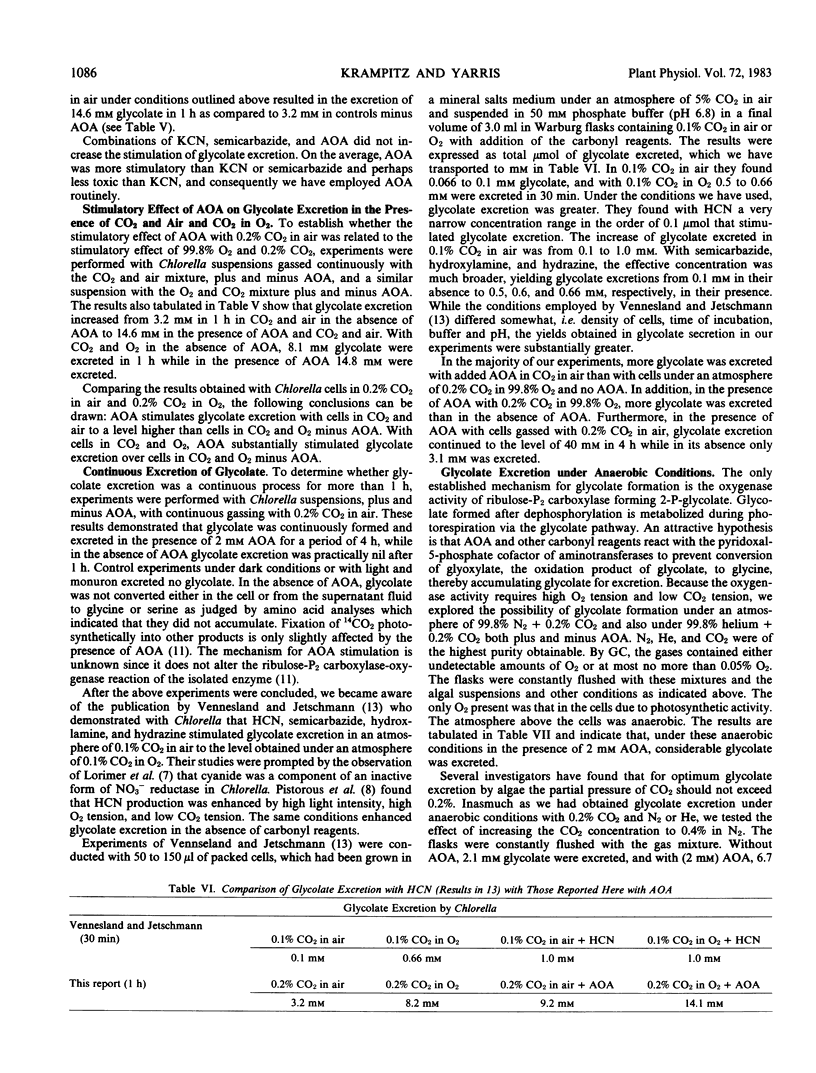Abstract
Conditions are described whereby suspensions of Chlorella pyrenoidosa and Netrium digitus photosynthetically biosynthesize and excrete glycolate continuously in high yields. Aminooxyacetic acid, an inhibitor of pyridoxal phosphate-linked enzymes, increased the excretion of glycolate approximately 4-fold in 1 hour (8 millimolar) and 20-fold in 4 hours (40 millimolar) in the presence of 0.2% CO2 in air. The amount of glycolate excreted in the presence of aminooxyacetate and an atmosphere of 0.2% CO2 in air equaled or exceeded the amount excreted in 0.2% CO2 in O2 minus aminooxyacetate. CO2 and light were required for glycolate excretion. Aminooxyacetate also stimulated photosynthetic glycolate excretion in an atmosphere of 0.2% CO2 in nitrogen or helium, although the stimulation was not as great as when air or O2 was present.
The excreted glycolate was converted to H2 and CO2 by the combined action of glycolic oxidase and the formic hydrogenlyase complex found in Escherichia coli in total conversion yields of 80%.
Full text
PDF



Selected References
These references are in PubMed. This may not be the complete list of references from this article.
- Andrews T. J., Lorimer G. H., Tolbert N. E. Ribulose diphosphate oxygenase. I. Synthesis of phosphoglycolate by fraction-1 protein of leaves. Biochemistry. 1973 Jan 2;12(1):11–18. doi: 10.1021/bi00725a003. [DOI] [PubMed] [Google Scholar]
- Hotta S. S. Oxidative metabolism of isolated brain mitochondria: changes caused by aminooxyacetate. Arch Biochem Biophys. 1968 Sep 20;127(1):132–139. doi: 10.1016/0003-9861(68)90209-9. [DOI] [PubMed] [Google Scholar]
- Lorimer G. H., Andrews T. J., Tolbert N. E. Ribulose diphosphate oxygenase. II. Further proof of reaction products and mechanism of action. Biochemistry. 1973 Jan 2;12(1):18–23. doi: 10.1021/bi00725a004. [DOI] [PubMed] [Google Scholar]
- Lorimer G. H., Gewitz H. S., Völker W., Solomonson L. P. The presence of bound cyanide in the naturally inactivated form of nitrate reductase of Chlorella vulgaris. J Biol Chem. 1974 Oct 10;249(19):6074–6079. [PubMed] [Google Scholar]
- RICHARDSON K. E., TOLBERT N. E. Phosphoglycolic acid phosphatase. J Biol Chem. 1961 May;236:1285–1290. [PubMed] [Google Scholar]
- TOLBERT N. E., ZILL L. P. Excretion of glycolic acid by algae during photosynthesis. J Biol Chem. 1956 Oct;222(2):895–906. [PubMed] [Google Scholar]
- Tolbert N. E., Harrison M., Selph N. Aminooxyacetate stimulation of glycolate formation and excretion by chlamydomonas. Plant Physiol. 1983 Aug;72(4):1075–1083. doi: 10.1104/pp.72.4.1075. [DOI] [PMC free article] [PubMed] [Google Scholar]
- ZELITCH I., OCHOA S. Oxidation and reduction of glycolic and glyoxylic acids in plants. I. Glycolic and oxidase. J Biol Chem. 1953 Apr;201(2):707–718. [PubMed] [Google Scholar]


